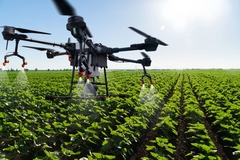Inside Symrise’s food tech hub: Diving into sustainable flavor concepts in Singapore
21 Dec 2023 --- Symrise has launched its “Enhanced Naturals @SPark” facility in Singapore, where the German taste and nutrition house is leading new developments in natural flavor craft, rescuing upcycled ingredients from waste side streams. It is also focusing on the biotransformation of food solutions through precision fermentation.
Food Ingredients First got an exclusive tour of the new facility, led by Bingxin Yee, senior research technologist at Symrise.
“Enhanced Naturals @Spark is our new innovation center, we only integrated it at the end of September. What we do here is produce natural, sustainable and authentic taste solutions for the future,” Yee tells us.

“At this innovation center, we cover three main capabilities. The first is biotransformation, which refers to enzymatic processes in food fermentation. The second is extraction and separation and the third is thermal processing. Each of these capabilities work in tandem with each other.”
Scaling biotransformation
Biotransformation, as the first target capability at the Enhanced Naturals @SPark facility, is defined as the biochemical conversion of natural ingredients by living organisms or enzyme preparations.
Symrise is scaling two areas of biotransformation. The first is enzymatic technology, which is the modification of natural fats like plant-based oils to deliver dairy notes such as “creamy,” “milky” and “buttery,” without dairy ingredients.
 The new innovation center covers biotransformation, extraction and separation and thermal ingredients processing of ingredients (Image credit: Symrise).The second area is precision fermentation, which harnesses bacterial cultures to produce new ingredients — imparting flavor, digestibility and shelf life.
The new innovation center covers biotransformation, extraction and separation and thermal ingredients processing of ingredients (Image credit: Symrise).The second area is precision fermentation, which harnesses bacterial cultures to produce new ingredients — imparting flavor, digestibility and shelf life.
Asia, especially Singapore, is considered a leading food technology hub for precision fermentation, Yee notes, while leading us through one laboratory at the Enhanced Naturals @SPark facility dedicated to biotransformation solutions.
“Governments have issued subsidies for start-ups focused on fermentation and alternative proteins,” he notes. “This laboratory equips us with our basic enzymatic or food fermentation capabilities, including precision fermentation.”
Precision fermentation has been gaining traction this year, as sector pioneers scale up bacteria-based systems to create animal-free dairy products such as milk, cream cheese and yogurt.
For instance, Imagindairy recently earned GRAS status in the US for its precision fermentation system, programmed with its proprietary AI to enable mass-scale production at costs that are at par with traditional dairy.
In other advances, key players in the precision fermentation space formed Food Fermentation Europe, a union championing precision fermentation as the “key to a sustainable food framework.”
“The fermentation-based dairy-free movement is slowly catching on in baby steps,” says Yee.
“We see big companies like Oatly or Oatside, they are already well integrated in the retail market. However, the Southeast Asia market is well positioned to receive these alternative dairy concepts. Many consumers here regularly drink soy milk.”
“As for meat alternatives, most people in this part of the world probably have already incorporated plant-based proteins as part of their meals, in dishes such as vegetarian fried bee hoon,” he continues.
Employing gentle processes
Extraction and separation are under the second Symrise capability category. The company employs gentle processes to isolate key natural taste and aroma compounds from agricultural produce.
A core part of Symrise’s extraction and separation activities is waste valorization. “We want to be a special partner to manufacturing companies to recover what has been lost through food waste streams, which still contain valuable flavor compounds that can be extracted. This can be done through technical assessments,” highlights Yee.
 The Symtrap technology recovers aroma and flavor compounds from waste streams (Image credit: Symrise).“In the zero waste ‘farm-to-table’ approach, everything from the farm should land on the table. Our capabilities at our facility here in Singapore can reduce waste by converting sidestreams into flavor, nutrition and health solutions.”
The Symtrap technology recovers aroma and flavor compounds from waste streams (Image credit: Symrise).“In the zero waste ‘farm-to-table’ approach, everything from the farm should land on the table. Our capabilities at our facility here in Singapore can reduce waste by converting sidestreams into flavor, nutrition and health solutions.”
As one example of upcycling coming into FMCG focus in Asia, Singaporean food science start-up KosmodeHealth repurposes spent barley grains — a food side stream generated after malt production — into W0Wnoodle, high-fiber noodles for blood sugar management. It was recently awarded “The Most Transformational Collaboration” at the 2023 SICC Awards in collaboration with Nestlé.
“In Asia, we are seeking to do more upcycling, given that we have very big agriculture markets like Vietnam, Thailand and China. When there’s a big supply of fresh materials that go into processing, there will be waste generated. Symrise wants to be an excellent research partner for these companies to see how we can recover value for them,” Yee tells us.
Symrise upcycles by recovering volatile aromas from food waste side streams using its Symtrap technology. The extraction method can draw out flavor and aromatizing molecules and nutritious compounds for food supplements.
“We can recover aroma compounds from mango side streams and put it back into a mango-flavored product, making it more authentic and natural,” details Yee, adding that the process can also be done for other produce like Thai limes.
“We are constantly exploring using the technologies for various approaches in different projects. The same technology we use for sweet and beverage-related flavors can also be used in vegetables, which is interesting for savory categories.”
Thermal processing
In the final laboratory explored on the guided tour, Yee led us through Symrise’s study in thermal processes of food analysis, which investigates the flavor and aroma compounds generated from heating food at various temperatures.
“Everything we do in this particular laboratory is related to heat,” states Yee. “We create products based on the concept of Maillard Reaction.”
 Maillard Reaction is the reason behind grilled steak's caramelized brown color and distinct flavor.He explained the concept with two examples. “The first is the caramelization of grilled steak. Another is the browning of bread, when sugar rises to the crust when it is grilled.”
Maillard Reaction is the reason behind grilled steak's caramelized brown color and distinct flavor.He explained the concept with two examples. “The first is the caramelization of grilled steak. Another is the browning of bread, when sugar rises to the crust when it is grilled.”
The Maillard reaction is a chemical reaction between amino acids along with a reduction of sugars through heat, which produces melanoidins — compounds that give food its browned color and a distinctive cooked flavor.
Symrise creates new intermediate ingredients for its flavors using the Maillard reaction, which produces volatile compounds that can be used in flavor solutions to bring culinary complexity. “Flavor, classically is both aroma and taste, so we look at these two components hand-in-hand,” says Yee.
The company runs through four steps to produce its ingredients using the Maillard reaction. The first involves the bioconversion of meat or plant hydrolysates to create a pool of taste active ingredients, which are then mixed with other ingredients like sugars, extracts or fats in the second step.
The third step is the thermal process in which the Maillard reaction is activated by heating the ingredients to yield molecules that deliver complex taste profiles.
In the final step, the ingredient mixture is spray-dried so that it can be transformed into a powder format.
“We are aiming to create lots of different flavors through this process,” Yee highlights. “We can create a chicken flavor without chicken and a chocolate flavor without using any cocoa extracts or chocolate materials.”
However, he underscores that the Maillard reaction is “not a silver bullet that can solve everything.”
“There are things that are more challenging because Maillard reaction-based ingredients in the food and beverage industry are typically considered artificial flavorings.”
He pointed toward versions that mimic the Maillard reaction but more in a natural process, which uses naturally derived food ingredients or raw materials derived from food.
Asia’s shift in palates toward naturality
Naturality and authenticity are considered key pillars at Enhanced Naturals @SPark. Asia’s diversified food landscape is seeing a gradual shift away from artificial additives that reflect similar dietary trends in Western markets.
“Ever since the pandemic in 2019, everyone has been getting more health conscious. And the move toward authenticity is in alignment with foods we consumed as children — home-cooked foods,” comments Yee.
 Symrise’s enzymatic technology modifies natural fats to deliver “creamy,” “milky” and “buttery” dairy notes without dairy ingredients (Image credit: Symrise).“Asian consumers are getting more educated on understanding ingredient lists,” he adds. “They focus on E-numbers and unfamiliar sounding names like maltodextrin. Companies like us are moving toward creating more clean label natural solutions.”
Symrise’s enzymatic technology modifies natural fats to deliver “creamy,” “milky” and “buttery” dairy notes without dairy ingredients (Image credit: Symrise).“Asian consumers are getting more educated on understanding ingredient lists,” he adds. “They focus on E-numbers and unfamiliar sounding names like maltodextrin. Companies like us are moving toward creating more clean label natural solutions.”
“In addition, different organizations across the world have various definitions of what can be considered as ‘natural.’ This is something we are looking into, in order for our customers to get the best products.”
Looking at Asia’s shift away from artificial additives, which are still prevalent across many local brands due to their low price point, Yee expects a fuller transition may still take some time to fully mature.
“This is because of the differentiated markets, particularly with regards to the premium segments in North Asia,” he notes. “In Korea and Japan, consumers are probably more willing to pay slightly more for natural labeling.”
“But when we talk about less developed markets, artificial flavors are probably still the way to go. However, all additives are very well regulated because food safety remains a top concern,” he concludes.
By Benjamin Ferrer, reporting from Singapore













